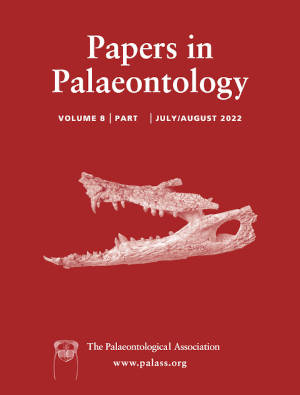Article: An early Cambrian mackenziid reveals links to modular Ediacaran macro-organisms
Publication: Papers in Palaeontology
Volume:
8
Part:
1
Publication Date:
2022
Article number:
e1412
Author(s):
Yang Zhao, Jakob Vinther, Yu-Jing Li, Fan Wei, Xian-Guang Hou, and Pei-Yun Cong
DOI:
10.1002/spp2.1412
Abstract
Abstract Many Ediacaran macrofossils are apparently composed of unique pneus (similar, repetitive tubular modules) forming a variety of body shapes by combinations of modular growth regimes. The large-scale disappearance of Ediacaran macro-organisms at the end of the Precambrian leaves this now extinct modular body plan only rarely reported from the Cambrian onwards. Mackenzia costalis is an enigmatic and poorly understood soft-bodied organism from the middle Cambrian, and is a possible surviving member of the Ediacaran macrobiota. Here, we describe a new mackenziid, Paramackenzia canalifera, from the early Cambrian Chengjiang biota, Yunnan Province, south-west China. It has a body plan comprising longitudinal tubular modules that are radially arranged to form a cylindrical body with a basal attachment. Each tubular module is enclosed by an inner and outer concentric membrane, separated from adjacent modules by a thin lamellar sheet. Infilling sediment and preservation of dark, basal stains at the inner and outer membranes reveal a pore–canal system within the lamellae, connecting the internal cavity to the exterior. This arrangement of tubular modules is similar to that of several macroscopic Ediacaran species, including erniettomorphs and dickinsoniomorphs, which were constructed of serial hydrostatic modules referred to as ‘pneus’. The mackenziid pore system is similar to that of sponges and archaeocyathids in function and feeding strategy, but the overall anatomy precludes affiliation to this phylum. We suggest that mackenziids are most likely to be a blastic or diploblastic anatomical grade of stem eumetazoans, similar to other modular Ediacaran macro-organisms.
